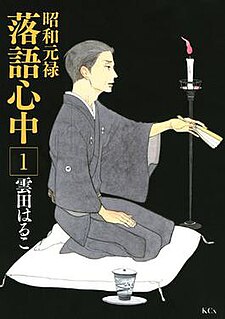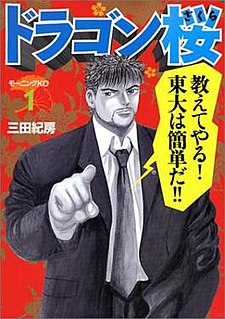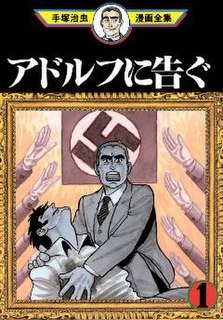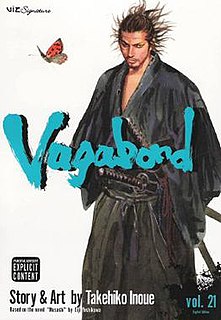 W
W20th Century Boys is a Japanese manga series written and illustrated by Naoki Urasawa. It was originally serialized in Big Comic Spirits from 1999 to 2006, with the 249 chapters published into 22 tankōbon volumes by Shogakukan. In January 2007, a sixteen chapter continuation titled 21st Century Boys ran until July, and was gathered into two tankōbon. It tells the story of Kenji Endō and his friends, who notice a cult-leader known only as "Friend" is out to destroy the world, and it has something to do with their childhood memories. The series makes many references to a number of manga and anime from the 1960s–1970s, as well as to classic rock music, its title being taken from T. Rex's song "20th Century Boy".
 W
WAkira, often stylized as AKIRA, is a Japanese cyberpunk manga series written and illustrated by Katsuhiro Otomo. It was initially serialized in the pages of Young Magazine, a seinen manga magazine, from 1982 until 1990, and then collected into six tankōbon volumes by its publisher Kodansha between 1984 and 1991. It was published in the United States by Marvel Comics under Epic Comics, becoming one of the first manga ever to be completely translated into English. It is currently published by Kodansha Comics in North America. Otomo's art is considered outstanding and a watershed for both Otomo and the manga form. The manga is also famous for spawning the seminal 1988 cyberpunk anime film adaptation of the same name.
 W
WBasilisk is a Japanese manga series written and illustrated by Masaki Segawa. It was published in Japan in 2003 and 2004 in Kodansha's Young Magazine Uppers magazine, based on the novel The Kouga Ninja Scrolls by Futaro Yamada published in 1958. The anime, produced in 2005 by Gonzo, closely follows the manga aside from a handful of distinctions. The manga won the 2004 Kodansha Manga Award for general manga. Segawa continued producing serialized adaptations of Futaro Yamada's novels with The Yagyu Ninja Scrolls in 2005, Yama Fu-Tang in 2010, and Jū: Ninpō Makai Tensei in 2012. Additionally, a two-part novel sequel titled The Ouka Ninja Scrolls: Basilisk New Chapter , penned by Masaki Yamada, was published in 2015 with illustrations by Segawa; a manga adaptation, Basilisk: The Ouka Ninja Scrolls , illustrated by Tatsuya Shihira with character designs by Masaki Segawa, was serialized between 2017 and 2019, and an anime adaptation by Seven Arcs Pictures aired in 2018.
 W
WBig Windup! , often shortened to just Ōfuri (おお振り), is a Japanese baseball-themed manga series written and illustrated by Asa Higuchi, serialized in the monthly seinen manga Afternoon magazine since November 2003.
 W
WBlue Period is a Japanese manga series written and illustrated by Tsubasa Yamaguchi. The series has been serialized in Kodansha's seinen manga magazine Monthly Afternoon since June 2017 and has been collected in 8 tankōbon volumes as of September 2020. The series is licensed in English by Kodansha Comics.
 W
WDescending Stories: Showa Genroku Rakugo Shinju is a Japanese manga series written and illustrated by Haruko Kumota. It began serialization in Kodansha's ITAN magazine in 2010. The manga is licensed in North America by Kodansha USA. The manga was adapted into two original video animations which were bundled with special editions of the seventh and eighth manga volumes on 6 March – 7 August 2015, respectively. It was also adapted into an anime television series which aired between 9 January 2016 and 2 April 2016. A second season of the anime television series aired between 7 January 2017 and 25 March 2017. A live-action series adaptation aired on NHK between 12 October and 14 December 2018.
 W
WDragon Head is a post-apocalyptic disaster manga by Minetaro Mochizuki. It was published by Kodansha in Young Magazine from 1995 and 2000 and collected in ten tankōbon volumes. It was licensed in English by Tokyopop, with Volume 10 released 2008-04-01. In 1997, the manga won the Kodansha Manga Award for general manga. Kodansha USA currently holds the license to the manga.
 W
WDragon Zakura is a Japanese manga series written and illustrated by Norifusa Mita. Serialized in Weekly Morning from 2003 to 2007, it was released into 21 tankōbon by Kodansha between October 22, 2003, and August 23, 2007. It was adapted into live action television series of the same name broadcast on TBS in 2005.
 W
WNobuyuki Fukumoto is a Japanese manga artist well known for his unique and original gambling ideas, deep psychological analyses of characters, and distinct artstyle. Yakuza and gambling are recurring themes in his manga. In English-speaking countries, he is known best as the author of Akagi, a mahjong-related manga. In 1998, he won the Kodansha Manga Award for Gambling Apocalypse: Kaiji. An onomatopoeia "zawa", meaning an uneasy atmosphere, appears frequently in his comics and is considered Fukumoto's trademark.
 W
WGiant Killing is Japanese manga series written by Masaya Tsunamoto and illustrated by Tsujitomo. A 26-episode anime adaptation animated by Studio Deen began airing in Japan on NHK on April 4, 2010. In 2010, it won the Kodansha Manga Award for best general manga.
 W
WGurazeni or Money Diamond, is a Japanese baseball manga series written by Yūji Moritaka and illustrated by Keiji Adachi. The manga was serialized between 2010 and 2014 and has been followed by two sequel series. An anime adaptation by Studio Deen covering 26 chapters of the manga ran from April to June and a second season from October to December 2018, each season lasting for 12 episodes.
 W
WHanada Shōnen Shi is a Japanese manga series written and illustrated by Makoto Isshiki about a mischievous young boy, called Hanada Ichiro, who attains the ability to see and talk to the supernatural after an accident to the back of his head. It was serialized in Mr. Magazine from 1993 to 1995. Hanada Shōnen Shi received the 1995 Kodansha Manga Award for the general category.
 W
WKosaku Shima is a Japanese manga series written and illustrated by Kenshi Hirokane. It depicts the growth and career of a fictional salaryman named Kōsaku Shima. It has been serialized in Kodansha's Weekly Morning, starting with the first series Kachō Shima Kōsaku in 1983 and has currently been divided into eight parts. The current part, Sōdanyaku Shima Kōsaku, began in 2019.
 W
WGambling Apocalypse: Kaiji is a Japanese manga series written and illustrated by Nobuyuki Fukumoto. It has been published by Kodansha in Weekly Young Magazine since February 1996. The story centers on Kaiji Itō, a consummate gambler and his misadventures around gambling. The series has currently been divided into six parts. The current part, Tobaku Datenroku Kaiji: 24 Oku Dasshutsu-hen, started in 2017.
 W
WMarch Comes In like a Lion , is a Japanese manga series written and illustrated by Chica Umino, best known for Honey and Clover. It began serialization in Hakusensha's seinen manga magazine Young Animal from its fourteenth issue in 2007.
 W
WMessage to Adolf , known in earlier English versions as Adolf, is a manga series made by Osamu Tezuka. The story is set before, during, and after World War II and is centered on three men with the name Adolf. Adolf Kamil is an Ashkenazi Jew living in Japan. His best friend Adolf Kaufmann is of both Japanese and German descent. The third Adolf is Adolf Hitler, the dictator of Germany. Adolf also features Sohei Toge, a Japanese reporter, and his quest for documents that could turn the tide of the war. The work explores the themes of nationality, ethnicity, racism, and war, and includes elements of coming of age, spy fiction, and historical drama.
 W
WShigeru Mizuki was a Japanese manga artist and historian, best known for his manga series GeGeGe no Kitarō. Born in a hospital in Osaka and raised in the city of Sakaiminato, Tottori, he later moved to Chōfu, Tokyo where he remained until his death. His pen-name, Mizuki, comes from the time when he managed an inn called 'Mizuki Manor' while he drew pictures for kamishibai. A specialist in stories of Yōkai, he is considered a master of the genre. Mizuki was also a noted historian, publishing works relating to world history, Japanese history, and his own World War II experience.
 W
WMushishi is a Japanese manga series written and illustrated by Yuki Urushibara. It was serialized in Afternoon Season Zōkan from 1999 to 2002, and in Monthly Afternoon from December 2002 to August 2008. The individual chapters were collected and released into ten tankōbon volumes by Kodansha. Those volumes were localized to North America by Del Rey between January 2007 and August 2010. The series follows Ginko, a man who dedicates himself to keeping people protected from supernatural creatures called Mushi.
 W
WNaniwa Kin'yudo is a Japanese manga series by Yūji Aoki which has been serialized in Weekly Morning since 1990. The series was awarded the 1992 Kodansha Manga Award for general manga and the 1998 Tezuka Osamu Cultural Prize Award for Excellence.
 W
WKatsuhiro Otomo is a Japanese manga artist, screenwriter and film director. He is best known as the creator of the manga Akira and its animated film adaptation. He was decorated a Chevalier of the French Ordre des Arts et des Lettres in 2005, promoted to Officier of the order in 2014, became the fourth manga artist ever inducted into the American Eisner Award Hall of Fame in 2012, and was awarded the Purple Medal of Honor from the Japanese government in 2013. Otomo later received the Winsor McCay Award at the 41st Annie Awards in 2014 and the 2015 Grand Prix de la ville d'Angoulême, the first manga artist to receive the award.
 W
WParasyte is a Japanese science fiction horror manga series written and illustrated by Hitoshi Iwaaki and published in Kodansha's Morning Open Zōkan and Monthly Afternoon magazine from 1988 to 1995. The manga was published in North America by first Tokyopop, then Del Rey, and finally Kodansha Comics.
 W
WPing-Pong Club is a Japanese manga by Minoru Furuya about the members of a middle school ping-pong club. In 1996, the manga won the Kodansha Manga Award for general manga.
 W
WPrison School is a Japanese manga series written and illustrated by Akira Hiramoto. It was serialized in Kodansha's Weekly Young Magazine from February 2011 to December 2017. Yen Press has licensed the manga in North America. A 12-episode anime adaptation directed by Tsutomu Mizushima aired between July and September 2015, while a live-action drama television series aired from October to December 2015.
 W
WMachiko Satonaka is a Japanese manga artist. She made her professional debut in 1964 during her second year of high school with the one-shot Pia no Shōzō. She has since created nearly 500 manga in a variety of genres. Two of her most notable works are Ashita Kagayaku, which won the 1974 Kodansha Publishing Culture Award, and Karyūdo no Seiza, which won the 1982 Kodansha Manga Award. In addition to creating manga, Satonaka teaches at the Osaka University of Arts as the head of the Character Creative Arts Department and serves on the board of various manga-related organizations in Japan.
 W
WShowa: A History of Japan, known in Japan as Comic Showa-shi , is a Japanese manga series written and illustrated by Shigeru Mizuki. A semi autobiographical work, this manga describes the author's experiences growing up during the Shōwa period. The author is a veteran of the Japanese army, but his series is filled with critical views of Japanese and American militarism.
 W
WThe Silent Service is a Japanese manga series written and illustrated by Kaiji Kawaguchi. It was published in Kodansha's Weekly Morning manga magazine from 1988 to 1996 and collected in 32 tankōbon volumes.
 W
WSōten Kōro , also known as Beyond the Heavens, is a Japanese manga series written and illustrated by King Gonta, adapted from an original story by Hagin Yi. It was serialized by Kodansha in the manga anthology magazine Weekly Morning from 1994 to 2005. After Hagin Yi died of cancer in September 1998, King Gonta picked up the story himself. A total of 409 chapters were published and compiled into 36 separate books.
 W
WSpace Brothers is a Japanese manga series by Chūya Koyama which has been serialized in Kodansha's Weekly Morning since December 2007. It has been nominated twice for the Manga Taishō, in 2009 and 2010. An anime adaptation by A-1 Pictures aired in Japan from April 1, 2012 to March 22, 2014. It was adapted into a live action film that premièred on May 5, 2012. An anime film premièred on August 9, 2014, titled Space Brothers #0.
 W
WOsamu Tezuka was a Japanese manga artist, cartoonist, and animator. Born in Osaka Prefecture, his prolific output, pioneering techniques, and innovative redefinitions of genres earned him such titles as "the Father of Manga", "the Godfather of Manga" and "the God of Manga". Additionally, he is often considered the Japanese equivalent to Walt Disney, who served as a major inspiration during Tezuka's formative years. Though this phrase praises the quality of his early manga works for children and animations, it also blurs the significant influence of his later, more literary, gekiga works.
 W
WNaoki Urasawa is a Japanese manga artist and musician. He has been drawing manga since he was four years old, and for most of his career has created two series simultaneously. Urasawa has been called one of the artists that changed the history of manga and has won numerous awards, including the Shogakukan Manga Award three times, the Tezuka Osamu Cultural Prize twice, and the Kodansha Manga Award once. By 2016, his various works had over 126 million copies in circulation.
 W
WVagabond is a Japanese epic martial arts manga series written and illustrated by Takehiko Inoue. It portrays a fictionalized account of the life of Japanese swordsman Musashi Miyamoto, based on Eiji Yoshikawa's novel Musashi.
 W
WVinland Saga is a Japanese historical manga series written and illustrated by manga author Makoto Yukimura. The series is published by Kodansha, and was first serialized in the youth-targeted Weekly Shōnen Magazine before moving to the monthly manga magazine Monthly Afternoon, aimed at young adult men. As of November 2019, the series has been compiled into twenty-three bound volumes. Vinland Saga has also been licensed for English-language publication by Kodansha USA.
 W
WWangan Midnight is a Japanese racing manga series written and illustrated by Michiharu Kusunoki. It was first serialized in Shogakukan's Big Comic Spirits in 1990, but was later serialized in Kodansha's Weekly Young Magazine from 1992 to 2008. The manga was compiled into 42 volumes published by Kodansha. A second manga series titled Wangan Midnight: C1 Runner was published from 2008 to 2012. A third manga series, Ginkai no Speed Star, was published from 2014 to 2015. A fourth manga series, Shutoko SPL - Ginkai no Speedster, started in 2016.
 W
WWaru is a Japanese josei manga written and illustrated by Jun Fukami.
 W
WWhat's Michael? is a Japanese manga series created by Makoto Kobayashi. In 1984, it began its serialization in the Weekly Morning magazine. The manga shows Michael, an orange American Shorthair tabby cat, his feline friends, and other domesticated pets in a series of humorous episodes. Michael is not a specific cat, but rather a feline version of the everyman as he appeared in drastically different settings across chapters: he's a normal cat in some chapters, an anthropomorphic cat in others, and he even dies in some chapters. Dark Horse Comics released the series in the US as eleven volumes between 1997 and 2006, and in 2020 released the first volume of a "Fatcat Collection", which spanned the first six volumes. The manga was presented in the standard left to right American reading format.
 W
WEiji Yoshikawa was a Japanese historical novelist. Among his best-known novels are revisions of older classics. He was mainly influenced by classics such as The Tale of the Heike, Tale of Genji, Water Margin, and Romance of the Three Kingdoms, many of which he retold in his own style. As an example, Yoshikawa took up Taiko's original manuscript in 15 volumes to retell it in a more accessible tone and reduce it to only two volumes. His other books also serve similar purposes and, although most of his novels are not original works, he created a huge amount of work and a renewed interest in the past. He was awarded the Cultural Order of Merit in 1960, the Order of the Sacred Treasure and the Mainichi Art Award just before his death from cancer in 1962. He is cited as one of the best historical novelists in Japan.
 W
WZipang is a Japanese manga written and illustrated by Kaiji Kawaguchi. Just like his previous work, The Silent Service, Zipang talks about the members of the Japan Maritime Self-Defense Force. It was first serialized in Kodansha's Weekly Morning magazine from 2000 until 2009, and published in 43 volumes. Four volumes have been translated into English by Ralph McCarthy for the Kodansha Bilingual Comics library. It was adapted into an anime in 2004.